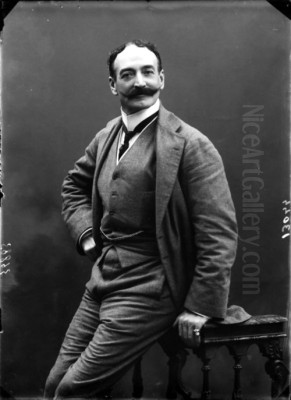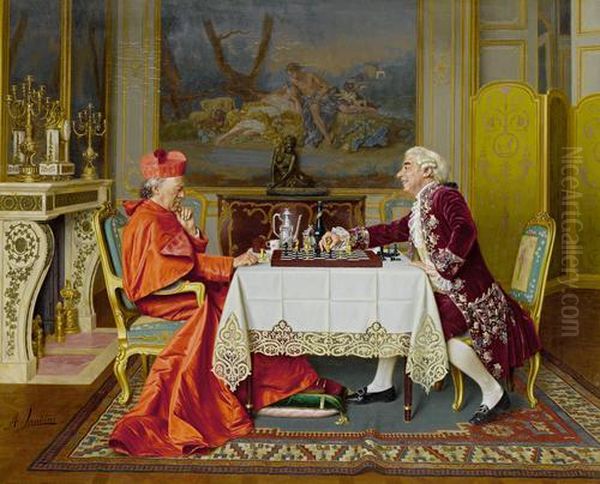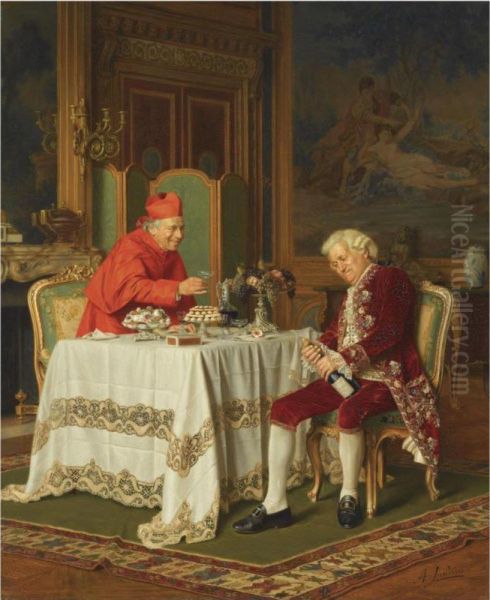
Andrea Landini stands as a notable figure in late 19th and early 20th-century European art, an Italian painter who carved a distinct niche for himself, particularly through his charming and meticulously rendered genre scenes. While he may not have been a revolutionary innovator in the vein of his Impressionist contemporaries, Landini excelled in a specific type of academic realism that delighted audiences with its technical skill, narrative charm, and often, its gentle humor. His works, especially those depicting cardinals in moments of leisure, continue to be appreciated for their decorative appeal and their window into the opulent aesthetics of a bygone era.
Nationality and Biographical Sketch
Andrea Landini was an Italian painter, born in Florence in 1847. Florence, the cradle of the Renaissance, provided a rich artistic environment for a young, aspiring artist. He received his formal artistic training at the prestigious Accademia di Belle Arti di Firenze (Academy of Fine Arts of Florence). This institution was a bastion of academic tradition, emphasizing rigorous training in drawing, perspective, and the study of Old Masters.
During his formative years in Florence, Landini would have been exposed to the lingering influence of Neoclassicism and Romanticism, as well as the burgeoning Macchiaioli movement, which was Italy's own version of an avant-garde, plein-air focused group, somewhat analogous to the French Impressionists. Artists like Giovanni Fattori and Telemaco Signorini were key figures in the Macchiaioli, though Landini's own path would diverge significantly from their stylistic concerns.
After establishing his foundational skills in Italy, Landini, like many ambitious artists of his generation, recognized that Paris was the undisputed capital of the art world. He relocated to Paris, a city teeming with artistic energy, diverse salons, and a wealthy clientele eager for new art. It was in Paris that Landini truly developed his signature style and achieved considerable success, particularly from the 1880s onwards. He remained active as a painter well into the early 20th century, passing away in 1935. His life thus spanned a period of immense artistic change, from the dominance of academic art to the rise of modernism.
Main Artistic Works and Stylistic Characteristics

Andrea Landini is best known for his genre paintings, often featuring sumptuously dressed figures in opulent interiors. His most iconic subjects are cardinals, depicted not in solemn religious duties, but in moments of worldly relaxation and refined leisure. These "cardinal paintings" became his trademark and were highly sought after.
Key Works:
Some of his most representative works include:
"The Cardinal's Pastime" (Le Passe-temps du Cardinal): This title, or variations of it, applies to several works where cardinals are shown playing musical instruments, examining art objects, or enjoying a quiet moment.
"A Game of Chess" (Une Partie d'Échecs): Depicting cardinals or other elegant figures engrossed in a chess match, a popular theme for genre painters.
"The Connoisseurs" (Les Connaisseurs): Often showing cardinals or gentlemen appreciating a painting, a sculpture, or a piece of porcelain, highlighting their refined tastes.
"An Interesting Story" (Une Histoire Intéressante): Cardinals being read to, or reading themselves, often with a hint of amusement or intrigue.
"Le Gouter des Cardinaux" (The Cardinals' Snack): Illustrating a moment of indulgence, with cardinals enjoying fine food and wine.
"The Duet" (Le Duo): Featuring figures, often including a cardinal, engaged in making music together.
"A Moment of Reflection" (Un Moment de Réflexion): Capturing a solitary figure, perhaps a cardinal, in quiet contemplation.
Stylistic Characteristics:
Landini's style is firmly rooted in Academic Realism. His paintings are characterized by:
1. Meticulous Detail: He paid extraordinary attention to the rendering of textures – the sheen of silk, the plushness of velvet, the gleam of polished wood, and the intricate patterns of lace and brocade. This tactile quality was a hallmark of his work.
2. Rich Color Palette: His use of color was vibrant and harmonious. The crimson reds of the cardinals' robes are particularly striking and became a signature element, often contrasted with deep greens, golds, and warm browns of the interiors.
3. Smooth Finish: Landini employed a polished, highly finished technique, with little visible brushwork, typical of academic painters who sought to create a seamless illusion of reality. This contrasted sharply with the broken brushwork of the Impressionists like Claude Monet or Pierre-Auguste Renoir.
4. Narrative Element: His paintings often tell a small story or capture a specific moment, inviting the viewer to imagine the context. There's frequently a subtle humor or a gentle irony in his depictions of these high-ranking church officials enjoying worldly pleasures.

5. Compositional Skill: His compositions are carefully arranged, balanced, and often draw the viewer's eye to the central figures and their activities. He was adept at creating a sense of depth and space within his interiors.
6. Emphasis on Elegance and Opulence: Landini's world is one of refinement, luxury, and comfort. His figures are always impeccably dressed, and their surroundings are filled with beautiful objects, antique furniture, and rich draperies.
His style can be compared to other European academic and genre painters of the era, such as the French artists Jean-Léon Gérôme for his historical precision (though Gérôme's subjects were often more dramatic or Orientalist) or Ernest Meissonier for his incredible detail in small-scale historical genre scenes. While Landini's subject matter was less grandiose than some of his contemporaries, his dedication to craftsmanship was comparable.
Anecdotes and Unofficial Stories
Specific, verifiable personal anecdotes about Andrea Landini are somewhat scarce in readily available art historical records, which is not uncommon for artists who were successful in their time but didn't achieve the legendary status of revolutionary figures. However, the "anecdotes" in Landini's case are often found within his paintings themselves.
His depictions of cardinals, for instance, were not meant to be deeply spiritual or critical. Instead, they often carried a lighthearted, almost winking quality. The cardinals are portrayed as cultivated gentlemen, enjoying the finer things in life – good food, wine, music, art, and intellectual pursuits like chess or reading. This portrayal could be seen as a gentle humanization of these powerful figures, making them relatable and even endearing to a bourgeois audience.
One could imagine that his choice of subject matter was also a shrewd commercial decision. These charming, beautifully painted scenes of cardinals in their resplendent robes and luxurious settings appealed greatly to the tastes of wealthy collectors in Paris and beyond. They were decorative, sophisticated, and carried an air of old-world charm that was highly fashionable. The recurring motif of cardinals, almost like a brand, made his work instantly recognizable.
It's also said that his attention to detail was so precise that he would meticulously research the costumes and interiors he depicted, ensuring a high degree of accuracy in the historical settings, even if the scenes themselves were fictionalized genre moments. This dedication to verisimilitude was a hallmark of the academic tradition.
Artistic Lineage and Collaborations
Andrea Landini's primary artistic lineage stems from his training at the Accademia di Belle Arti di Firenze. During the mid-19th century, prominent figures associated with the Florentine Academy included painters like Stefano Ussi (1822-1901), known for his historical paintings, and Antonio Ciseri (1821-1891), a Swiss-Italian painter acclaimed for his religious and portrait works executed with remarkable realism. While direct mentorship by these specific artists isn't always explicitly documented for every student, Landini would have undoubtedly been influenced by their teachings and the prevailing academic methods they championed. This training emphasized strong draftsmanship, anatomical accuracy, and the study of Renaissance masters like Raphael and Titian.
Upon moving to Paris, Landini would have entered a vibrant and competitive art scene. While there's no strong evidence of direct, formal collaborations in the sense of co-painting works, artists in Paris often moved in similar circles, exhibited at the same Salons, and were aware of each other's successes and stylistic trends. He would have been a contemporary of many successful academic painters in Paris.
His work shares thematic affinities with other painters of "cardinal scenes," a subgenre that was popular in the 19th century. Artists like the French painter Georges Crogaert (1848-1923), a Belgian who also worked in Paris, specialized in similar subjects, often with a humorous or anecdotal touch. The Spanish master Mariano Fortuny (1838-1874), though with a more dazzling and painterly technique, also depicted Rococo-revival scenes and ecclesiastics with a keen eye for detail and costume.
Landini's focus on elegant interiors and refined social interactions also aligns him broadly with other Italian artists who found success in Paris, such as Giovanni Boldini (1842-1931) and Giuseppe De Nittis (1846-1884). However, Boldini developed a much more flamboyant and dynamic style for his society portraits, and De Nittis was more aligned with a softer, more atmospheric realism often capturing Parisian street life. Landini's approach remained more traditionally academic and focused on intimate interior scenes. Another contemporary Italian, Vittorio Matteo Corcos (1859-1933), also painted elegant society figures, often with a psychological depth that differed from Landini's more straightforward genre narratives.
Affiliated Art Movements or Groups
Andrea Landini is most accurately classified as an exponent of Academic Art or Academic Realism. This was the dominant artistic style sanctioned by the official academies of art in Europe throughout much of the 19th century. Academic art prioritized:
Hierarchy of Genres: With historical and religious painting at the top, followed by portraiture, genre painting, landscape, and still life. Landini excelled in genre painting, elevating it with his refined technique.
Technical Skill: Emphasis on flawless drawing, smooth finish, realistic depiction of anatomy, light, and texture.
Idealization: Even in realistic depictions, there was often an element of idealization or beautification.
Traditional Subject Matter: Drawing from history, mythology, religion, or, as in Landini's case, carefully constructed scenes of everyday life (genre).
While he was working in Florence, the Macchiaioli movement was active. This group, including artists like Giovanni Fattori, Silvestro Lega, and Telemaco Signorini, reacted against the strictures of academic art, advocating for painting outdoors ("en plein air") and using "macchie" (patches or spots of color) to capture the immediate effects of light and shadow. Landini's path did not follow theirs; instead, he pursued the more traditional and internationally recognized academic style, which found a larger market, especially in Paris.
In Paris, Landini was contemporary with the rise of Impressionism (Claude Monet, Pierre-Auguste Renoir, Edgar Degas) and later Post-Impressionism (Vincent van Gogh, Paul Cézanne, Paul Gauguin). These avant-garde movements actively rebelled against the academic tradition that Landini represented. While the Impressionists were capturing fleeting moments and the effects of light with broken brushwork, Landini continued to produce highly finished, detailed narrative paintings.
Therefore, Landini was not part of an avant-garde movement but rather a successful practitioner within the established academic system. His work catered to the tastes of a clientele that appreciated technical mastery, narrative clarity, and decorative elegance over radical artistic innovation. He can be seen alongside other successful Salon painters of his time who maintained these traditions, such as William-Adolphe Bouguereau in France, whose mythological and allegorical scenes were immensely popular, or even genre specialists like Jean Béraud, who captured Parisian social life with a similar attention to detail, though often in outdoor or public settings.
Important Exhibition Records and Collecting Institutions
Andrea Landini achieved significant recognition through his participation in the prestigious Paris Salon. The Salon, organized by the Académie des Beaux-Arts, was the most important official art exhibition in the Western world for much of the 19th century. Exhibiting regularly at the Salon was crucial for an artist's reputation and commercial success. Landini is recorded as having exhibited there from at least 1880, and his charming genre scenes, particularly those featuring cardinals, were well-received by both critics who favored academic work and the buying public.
His success at the Paris Salon indicates that his work was judged to be of high technical quality and appealing subject matter according to the standards of the time. Beyond the Paris Salon, it is likely he also exhibited in other European cities, as successful artists often sought wider exposure. There might be records of his participation in exhibitions in London, Brussels, or major Italian cities, though the Paris Salon remains his most significant documented venue.
Regarding collecting institutions, Landini's paintings are predominantly found in private collections worldwide. His works were highly popular among bourgeois and aristocratic collectors during his lifetime and have remained desirable in the art market, particularly for those who appreciate 19th-century academic and genre painting.
While major national museums with vast collections might hold examples of his work, they are more commonly found in smaller regional museums or have passed through prominent auction houses over the decades. For instance, works by Landini occasionally appear at auctions by Sotheby's, Christie's, and Bonhams. The specific whereabouts of many of his paintings are often with private individuals rather than in public museum databases, which is typical for artists who specialized in this kind of marketable genre work.
To locate specific works in public collections, one would typically need to consult museum collection databases or specialized art historical archives. However, the enduring appeal of his paintings ensures they are well-documented in auction catalogues and art market resources, testifying to his continued, if specialized, appreciation. His legacy is that of a skilled and charming painter who perfectly captured a particular aesthetic sensibility of his era, leaving behind a body of work that continues to delight with its elegance and meticulous craftsmanship.